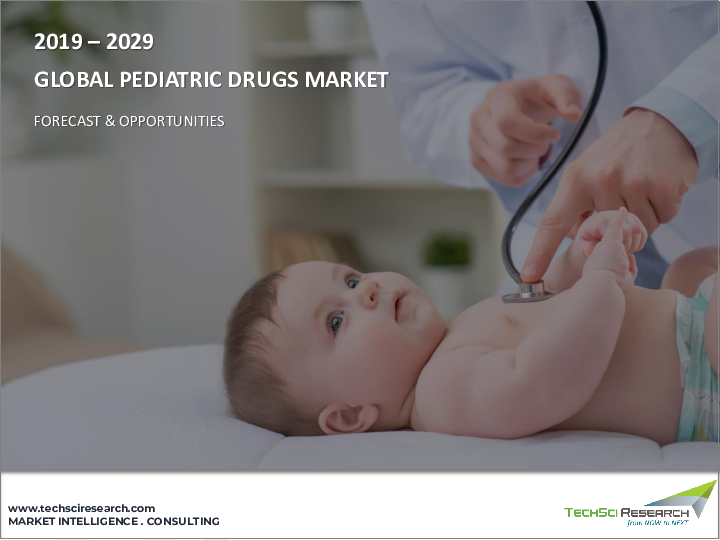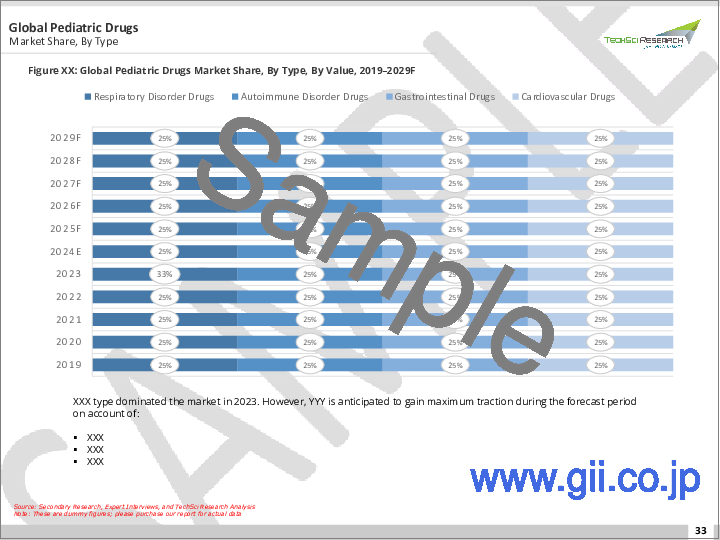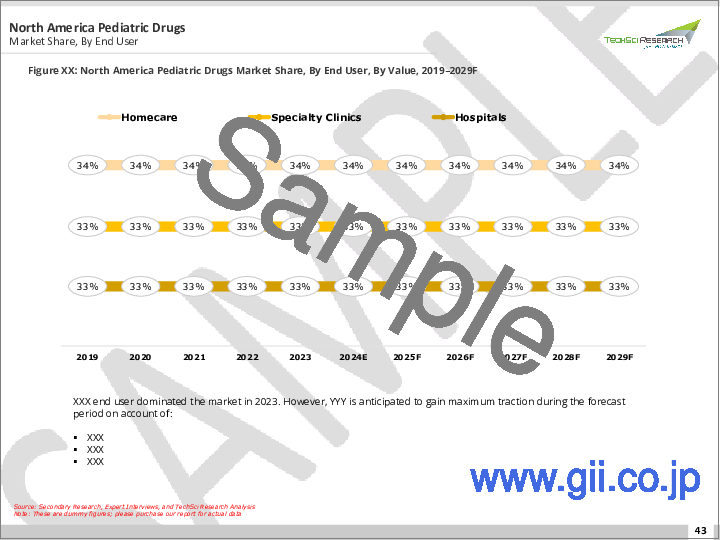|
|
市場調査レポート
商品コード
1370929
小児用医薬品市場- 世界の産業規模、シェア、動向、機会、予測、2018年~2028年タイプ別、投与経路別、エンドユーザー別、地域別、競合市場別分析Pediatric Drugs Market - Global Industry Size, Share, Trends, Opportunity, and Forecast, 2018-2028 Segmented By Type, By Route Of Administration, By End-User, By Region, By Competition |
||||||
カスタマイズ可能
|
|||||||
| 小児用医薬品市場- 世界の産業規模、シェア、動向、機会、予測、2018年~2028年タイプ別、投与経路別、エンドユーザー別、地域別、競合市場別分析 |
|
出版日: 2023年10月03日
発行: TechSci Research
ページ情報: 英文 178 Pages
納期: 2~3営業日
|
- 全表示
- 概要
- 目次
世界の小児用医薬品市場は、2022年に1,185億4,000万米ドルの評価額に達し、予測期間を通じて目覚ましい成長を遂げ、2028年までの年間平均成長率(CAGR)は5.71%と予測され、2028年には1,650億2,000万米ドルに達すると見込まれています。
小児用医薬品市場は、乳幼児、小児、青少年に安全で有効な治療を提供することに重点を置く製薬業界の中でも重要な分野です。若年層のヘルスケアニーズに応えるには、彼ら特有の生理的・発達的要件に合わせた特殊な医薬品が必要です。小児用医薬品市場は、医学研究の進歩、規制当局の取り組み、小児期の健康上の懸念に対処することの重要性に対する認識の高まりなどを背景に、長期にわたって大幅な成長を遂げてきました。
米国食品医薬品局(FDA)や欧州医薬品庁(EMA)などの規制機関は、独占権の延長や金銭的報酬などのインセンティブを通じて、製薬企業に小児用医薬品開発への投資を促してきました。こうした取り組みにより、小児を対象とした研究開発(R&D)が活発化しています。慢性疾患(喘息、糖尿病、神経疾患など)や感染症(COVID-19など)といった疾患は、製薬企業にこれらの健康課題に対するオーダーメイドの治療法に集中するよう促しています。
ゲノミクス、薬理学、ドラッグデリバリーの科学的進歩により、より正確で個別化された小児用医薬品の製剤化が容易になったため、小児に適した革新的な製剤への投資が活発化しています。小児用医薬品市場は、規制の推進、科学の進歩、小児特有のヘルスケア要件に対する認識の高まりに後押しされ、進化を続けています。
| 市場概要 | |
|---|---|
| 予測期間 | 2024-2028 |
| 市場規模 | 1,185億4,000万米ドル |
| 2028年の市場規模 | 1,650億2,000万米ドル |
| CAGR 2023-2028 | 5.71% |
| 急成長セグメント | オンライン薬局 |
| 最大市場 | 北米 |
市場促進要因
小児人口の増加
人口動態の変化により、小児人口の増加が顕著になっています。国連によると、2050年までに0~14歳の世界人口は22億人に達すると予測されています。この急増は、小児ヘルスケアへの注目の高まりを強調し、小児に特化した医薬品の需要を促進しています。小児特有の生理機能により、安全性と有効性を優先した特殊な治療が必要とされています。
小児疾患の発生率の増加
医療の進歩により小児の死亡率が低下する一方で、慢性疾患や希少疾患の罹患率は増加しています。小児がん、自己免疫疾患、先天性疾患、精神疾患などの症状はより顕著になっており、個別の医療ケアや治療が必要となっています。
主な市場課題
倫理および安全性への配慮
未成年者を対象とする臨床試験の実施には、子どもの脆弱性や症状発現の潜在的困難性から、慎重な倫理的判断が必要となります。データ取得と参加者の幸福のバランスをとることが課題となります。
研究開発の焦点の欠如
歴史的に、倫理的な懸念やロジスティクスの複雑さから、臨床試験において小児の参加は少ないです。この希少性が、小児のニーズに合わせてデザインされたエビデンスに裏打ちされた治療法の利用を妨げています。
投与と製剤の複雑さ
小児患者のダイナミックな成長には、成人とは異なる投与法や剤形へのアプローチが必要です。年齢に適した剤形と用量を開発することは複雑であり、誤った投与結果を避けるために極めて重要です。
主な市場動向
技術の進歩
技術の飛躍的進歩は小児医療を再構築し、診断、治療、医薬品開発の状況を変化させています。精密医療、薬理ゲノミクス、デジタルヘルス技術、人工知能(AI)は、治療のカスタマイズ、実世界でのエビデンス収集、創薬を強化することで、小児医療に革命をもたらしています。
セグメント別インサイト
タイプ別インサイト
呼吸器疾患治療薬セグメントは、小児集団における喘息や気管支炎などの疾患の有病率を反映して、支配的なセグメントです。アレルゲン、感染症、環境要因への曝露が増加していることが、呼吸器疾患の隆盛に寄与しています。
最終用途の洞察
病院は、小児医療を専門的に提供しているため、主要なエンドユーザーです。専門部門と診断ツールにより、病院は総合的な小児治療の一次情報源として位置づけられています。
地域別洞察
強固な製薬業界、研究機関、良好な規制枠組みを有する北米が、小児用医薬品市場を牽引しています。小児研究公正法(PREA)や臨床試験インフラなどのイニシアチブが成長に寄与しています。
目次
第1章 概要
第2章 調査手法
第3章 COVID-19が世界の小児用医薬品市場に与える影響
第4章 顧客の声
第5章 エグゼクティブサマリー
第6章 ファージ療法の世界市場概要
第7章 小児用医薬品の世界市場展望
- 市場規模・予測
- 金額別
- 市場シェアと予測
- タイプ別(呼吸器疾患治療薬、自己免疫疾患治療薬、消化器疾患治療薬、循環器疾患治療薬)
- 投与経路別(経口剤、局所剤、非経口剤、その他)
- エンドユーザー別(病院、専門クリニック、在宅医療)
- 企業別(2022年)
- 地域別
- 市場マップ
- タイプ別
- 投与経路別
- エンドユーザー別
第8章 北米小児用医薬品市場展望
- 市場規模・予測
- 金額別
- 市場シェアと予測
- タイプ別
- 投与経路別
- エンドユーザー別
- 国別
- 政策・規制状況
- 北米国別分析
- 米国
- メキシコ
- カナダ
第9章 欧州の小児用医薬品市場展望
- 市場規模および予測
- 金額別
- 市場シェアと予測
- タイプ別
- 投与経路別
- エンドユーザー別
- 国別
- 政策・規制状況
- 欧州国別分析
- フランス
- ドイツ
- 英国
- イタリア
- スペイン
第10章 アジア太平洋地域の小児用医薬品市場展望
- 市場規模・予測
- 金額別
- 市場シェアと予測
- タイプ別
- 投与経路別
- エンドユーザー別
- 国別
- 政策・規制状況
- アジア太平洋地域国別分析
- 中国
- インド
- 日本
- 韓国
- オーストラリア
第11章 南米の小児用医薬品市場展望
- 市場規模および予測
- 金額別
- 市場シェアと予測
- タイプ別
- 投与経路別
- エンドユーザー別
- 国別
- 政策と規制状況
- 南米国別分析
- ブラジル
- アルゼンチン
- コロンビア
第12章 中東・アフリカの小児用医薬品市場展望
- 市場規模および予測
- 金額別
- 市場シェアと予測
- タイプ別
- 投与経路別
- エンドユーザー別
- 国別
- 政策と規制状況
- MEA:国別分析
- 南アフリカ
- サウジアラビア
- アラブ首長国連邦
第13章 市場力学
- 促進要因
- 課題
第14章 市場動向と発展
第15章 ポーターのファイブフォース分析
第16章 世界の小児用医薬品市場SWOT分析
第17章 動物用ファージの市販品目一覧
第18章 競合情勢
- Business Overview
- Company Snapshot
- Types & Services
- Financials(In case of listed companies)
- Recent Developments
- SWOT Analysis
- BioMarin
- Horizon Therapeutics plc
- Gilead Sciences Inc.
- Sumitomo Pharma Co., Ltd.
- Jazz Pharmaceuticals, Inc.
- GlaxoSmithKline plc.
- Abbott
- F. Hoffman La Roche, Ltd.
- Boehringer Ingelheim International GmbH
- Johnson & Johnson Services, Inc.
- Novartis AG
- Pfizer, Inc.
第19章 戦略的提言
第20章 調査会社・免責事項
The Global Pediatric Drugs Market reached a valuation of USD 118.54 Billion in 2022, and it is poised for impressive growth throughout the forecast period, with a projected Compound Annual Growth Rate (CAGR) of 5.71% up to 2028 and expected to reach USD 165.02 Billion by 2028. The pediatric drugs market represents a critical sector within the pharmaceutical industry, focused on delivering safe and efficacious treatments for infants, children, and adolescents. Meeting the healthcare needs of the younger demographic necessitates specialized medications tailored to their unique physiological and developmental requirements. The market for pediatric drugs has experienced substantial growth over time, driven by advancements in medical research, regulatory initiatives, and an increased recognition of the significance of addressing childhood health concerns.
Regulatory bodies such as the U.S. Food and Drug Administration (FDA) and the European Medicines Agency (EMA) have encouraged pharmaceutical enterprises to invest in pediatric drug development through incentives like exclusivity extensions and financial rewards. These initiatives have sparked heightened research and development (R&D) endeavors directed at pediatric populations. Conditions such as chronic ailments (e.g., asthma, diabetes, neurological disorders) and infectious diseases (e.g., COVID-19) have impelled pharmaceutical companies to concentrate on tailored therapies for these health challenges.
Scientific progress in genomics, pharmacology, and drug delivery has facilitated the formulation of more precise and individualized pediatric medications, thus prompting augmented investment in innovative formulations suitable for children. The pediatric drugs market's evolution persists, buoyed by regulatory drives, scientific advancements, and an enhanced awareness of the distinctive healthcare prerequisites of children.
| Market Overview | |
|---|---|
| Forecast Period | 2024-2028 |
| Market Size 2022 | USD 118.54 Billion |
| Market Size 2028 | USD 165.02 Billion |
| CAGR 2023-2028 | 5.71% |
| Fastest Growing Segment | Online Pharmacies |
| Largest Market | North America |
Key Market Drivers
Rising Pediatric Population
The demographic landscape is witnessing a shift, with a notable rise in the pediatric population. By 2050, the global population aged 0-14 is projected to reach 2.2 billion according to the United Nations. This surge underscores the heightened focus on pediatric healthcare, driving the demand for medications tailored to children. Their unique physiology necessitates specialized treatments that prioritize safety and efficacy.
Increasing Incidence of Pediatric Diseases
While advancements in medicine have led to reduced mortality rates among children, the prevalence of chronic and rare diseases has escalated. Conditions such as childhood cancers, autoimmune disorders, congenital diseases, and mental health disorders are more pronounced, compelling tailored medical attention and therapies.
Key Market Challenges
Ethical and Safety Considerations
Conducting clinical trials involving minors requires careful ethical navigation due to children's vulnerability and potential difficulties in symptom expression. Balancing data acquisition and participant well-being poses a challenge.
Lack of R&D Focus
Historically, children have been underrepresented in clinical trials due to ethical concerns and logistical complexities. This scarcity impedes the availability of evidence-backed treatments designed for children's needs.
Dosing and Formulation Complexity
Pediatric patients' dynamic growth necessitates distinct approaches to dosing and drug forms compared to adults. Developing age-appropriate dosage forms and dosages is intricate and crucial to avoid incorrect dosing outcomes.
Key Market Trends
Technological Advancements
Technological breakthroughs are reshaping pediatric medicine, altering diagnosis, treatment, and drug development landscapes. Precision medicine, pharmacogenomics, digital health technologies, and artificial intelligence (AI) are revolutionizing pediatric healthcare by enhancing treatment customization, real-world evidence collection, and drug discovery.
Segmental Insights
Type Insights
The Respiratory Disorder Drugs segment is the dominant segment, reflecting the prevalence of conditions like asthma and bronchitis in pediatric populations. The rising exposure to allergens, infections, and environmental factors contributes to respiratory disorders' prominence.
End-Use Insights
Hospitals are the major end-users due to their expertise in offering tailored pediatric care. Specialized departments and diagnostic tools position hospitals as the primary source of comprehensive pediatric treatment.
Regional Insights
North America, with its robust pharmaceutical industry, research institutions, and favorable regulatory framework, drives the pediatric drugs market. Initiatives like the Pediatric Research Equity Act (PREA) and clinical trial infrastructure contribute to growth.
The forecasted period presents opportunities for growth and innovation in the pediatric drugs market. The industry's response to ethical concerns, formulation complexity, and unique pediatric needs, coupled with advancements in precision medicine, digital health, collaboration, and rare disease treatment, can shape the future of pediatric healthcare positively. By embracing these challenges and capitalizing on opportunities, the pharmaceutical sector can contribute significantly to pediatric well-being and healthcare advancement.
Key Market Players
- BioMarin
- Horizon Therapeutics plc
- Gilead Sciences Inc.
- Sumitomo Pharma Co., Ltd.
- Jazz Pharmaceuticals, Inc.
- GlaxoSmithKline plc.
- Abbott
- F. Hoffman La Roche, Ltd.
- Boehringer Ingelheim International GmbH
- Johnson & Johnson Services, Inc.
- Novartis AG
- Pfizer, Inc.
Report Scope:
- In this report, the Global Pediatric Drugs Market has been segmented into the following categories, in addition to the industry trends which have also been detailed below.
Pediatric Drugs Market, By Type:
- Respiratory Disorder Drugs
- Autoimmune Disorder Drugs
- Gastrointestinal Drugs
- Cardiovascular Drugs
Pediatric Drugs Market, By Route Of Administration:
- Oral
- Topical
- Parenteral
- Others
Pediatric Drugs Market, By End-Use:
- Hospitals
- Specialty Clinics
- Homecare
Pediatric Drugs Market, By Region:
- North America
- Asia-Pacific
- Europe
- Middle East & Africa
- South America
Competitive Landscape
- Company Profiles: Detailed analysis of the major companies present in the Global Pediatric Drugs Market.
Available Customizations:
- Global Pediatric Drugs Market report with the given market data, TechSci Research offers customizations according to a company's specific needs. The following customization options are available for the report:
Company Information
- Detailed analysis and profiling of additional market players (up to five).
Table of Contents
1. Product Overview
2. Research Methodology
3. Impact of COVID-19 on Global Pediatric Drugs Market
4. Voice of Customer
5. Executive Summary
6. Global Phage Therapy Market Overview
7. Global Pediatric Drugs Market Outlook
- 7.1. Market Size & Forecast
- 7.1.1. By Value
- 7.2. Market Share & Forecast
- 7.2.1. By Type (Respiratory Disorder Drugs, Autoimmune Disorder Drugs, Gastrointestinal Drugs, Cardiovascular Drugs)
- 7.2.2. By Route Of Administration (Oral, Topical, Parenteral, Others)
- 7.2.3. By End User (Hospitals, Specialty Clinics, Homecare)
- 7.2.4. By Company (2022)
- 7.2.5. By Region
- 7.3. Market Map
- 7.3.1. By Type
- 7.3.2. By Route Of Administration
- 7.3.3. By End User
8. North America Pediatric Drugs Market Outlook
- 8.1. Market Size & Forecast
- 8.1.1. By Value
- 8.2. Market Share & Forecast
- 8.2.1. By Type
- 8.2.2. By Route Of Administration
- 8.2.3. By End User
- 8.2.4. By Country
- 8.3. Policy & Regulatory Landscape
- 8.4. North America: Country Analysis
- 8.4.1. United States Pediatric Drugs Market Outlook
- 8.4.1.1. Market Size & Forecast
- 8.4.1.1.1. By Value
- 8.4.1.2. Market Share & Forecast
- 8.4.1.2.1. By Type
- 8.4.1.2.2. By Route Of Administration
- 8.4.1.2.3. By End User
- 8.4.1.1. Market Size & Forecast
- 8.4.2. Mexico Pediatric Drugs Market Outlook
- 8.4.2.1. Market Size & Forecast
- 8.4.2.1.1. By Value
- 8.4.2.2. Market Share & Forecast
- 8.4.2.2.1. By Type
- 8.4.2.2.2. By Route Of Administration
- 8.4.2.2.3. By End User
- 8.4.2.1. Market Size & Forecast
- 8.4.3. Canada Pediatric Drugs Market Outlook
- 8.4.3.1. Market Size & Forecast
- 8.4.3.1.1. By Value
- 8.4.3.2. Market Share & Forecast
- 8.4.3.2.1. By Type
- 8.4.3.2.2. By Route Of Administration
- 8.4.3.2.3. By End User
- 8.4.3.1. Market Size & Forecast
- 8.4.1. United States Pediatric Drugs Market Outlook
9. Europe Pediatric Drugs Market Outlook
- 9.1. Market Size & Forecast
- 9.1.1. By Value
- 9.2. Market Share & Forecast
- 9.2.1. By Type
- 9.2.2. By Route Of Administration
- 9.2.3. By End User
- 9.2.4. By Country
- 9.3. Policy & Regulatory Landscape
- 9.4. Europe: Country Analysis
- 9.4.1. France Pediatric Drugs Market Outlook
- 9.4.1.1. Market Size & Forecast
- 9.4.1.1.1. By Value
- 9.4.1.2. Market Share & Forecast
- 9.4.1.2.1. By Type
- 9.4.1.2.2. By Route Of Administration
- 9.4.1.2.3. By End User
- 9.4.1.1. Market Size & Forecast
- 9.4.2. Germany Pediatric Drugs Market Outlook
- 9.4.2.1. Market Size & Forecast
- 9.4.2.1.1. By Value
- 9.4.2.2. Market Share & Forecast
- 9.4.2.2.1. By Type
- 9.4.2.2.2. By Route Of Administration
- 9.4.2.2.3. By End User
- 9.4.2.1. Market Size & Forecast
- 9.4.3. United Kingdom Pediatric Drugs Market Outlook
- 9.4.3.1. Market Size & Forecast
- 9.4.3.1.1. By Value
- 9.4.3.2. Market Share & Forecast
- 9.4.3.2.1. By Type
- 9.4.3.2.2. By Route Of Administration
- 9.4.3.2.3. By End User
- 9.4.3.1. Market Size & Forecast
- 9.4.4. Italy Pediatric Drugs Market Outlook
- 9.4.4.1. Market Size & Forecast
- 9.4.4.1.1. By Value
- 9.4.4.2. Market Share & Forecast
- 9.4.4.2.1. By Type
- 9.4.4.2.2. By Route Of Administration
- 9.4.4.2.3. By End User
- 9.4.4.1. Market Size & Forecast
- 9.4.5. Spain Pediatric Drugs Market Outlook
- 9.4.5.1. Market Size & Forecast
- 9.4.5.1.1. By Value
- 9.4.5.2. Market Share & Forecast
- 9.4.5.2.1. By Type
- 9.4.5.2.2. By Route Of Administration
- 9.4.5.2.3. By End User
- 9.4.5.1. Market Size & Forecast
- 9.4.1. France Pediatric Drugs Market Outlook
10. Asia-Pacific Pediatric Drugs Market Outlook
- 10.1. Market Size & Forecast
- 10.1.1. By Value
- 10.2. Market Share & Forecast
- 10.2.1. By Type
- 10.2.2. By Route Of Administration
- 10.2.3. By End User
- 10.2.4. By Country
- 10.3. Policy & Regulatory Landscape
- 10.4. Asia-Pacific: Country Analysis
- 10.4.1. China Pediatric Drugs Market Outlook
- 10.4.1.1. Market Size & Forecast
- 10.4.1.1.1. By Value
- 10.4.1.2. Market Share & Forecast
- 10.4.1.2.1. By Type
- 10.4.1.2.2. By Route Of Administration
- 10.4.1.2.3. By End User
- 10.4.1.1. Market Size & Forecast
- 10.4.2. India Pediatric Drugs Market Outlook
- 10.4.2.1. Market Size & Forecast
- 10.4.2.1.1. By Value
- 10.4.2.2. Market Share & Forecast
- 10.4.2.2.1. By Type
- 10.4.2.2.2. By Route Of Administration
- 10.4.2.2.3. By End User
- 10.4.2.1. Market Size & Forecast
- 10.4.3. Japan Pediatric Drugs Market Outlook
- 10.4.3.1. Market Size & Forecast
- 10.4.3.1.1. By Value
- 10.4.3.2. Market Share & Forecast
- 10.4.3.2.1. By Type
- 10.4.3.2.2. By Route Of Administration
- 10.4.3.2.3. By End User
- 10.4.3.1. Market Size & Forecast
- 10.4.4. South Korea Pediatric Drugs Market Outlook
- 10.4.4.1. Market Size & Forecast
- 10.4.4.1.1. By Value
- 10.4.4.2. Market Share & Forecast
- 10.4.4.2.1. By Type
- 10.4.4.2.2. By Route Of Administration
- 10.4.4.2.3. By End User
- 10.4.4.1. Market Size & Forecast
- 10.4.5. Australia Pediatric Drugs Market Outlook
- 10.4.5.1. Market Size & Forecast
- 10.4.5.1.1. By Value
- 10.4.5.2. Market Share & Forecast
- 10.4.5.2.1. By Type
- 10.4.5.2.2. By Route Of Administration
- 10.4.5.2.3. By End User
- 10.4.5.1. Market Size & Forecast
- 10.4.1. China Pediatric Drugs Market Outlook
11. South America Pediatric Drugs Market Outlook
- 11.1. Market Size & Forecast
- 11.1.1. By Value
- 11.2. Market Share & Forecast
- 11.2.1. By Type
- 11.2.2. Route Of Administration
- 11.2.3. By End User
- 11.2.4. By Country
- 11.3. Policy & Regulatory Landscape
- 11.4. South America: Country Analysis
- 11.4.1. Brazil Pediatric Drugs Market Outlook
- 11.4.1.1. Market Size & Forecast
- 11.4.1.1.1. By Value
- 11.4.1.2. Market Share & Forecast
- 11.4.1.2.1. By Type
- 11.4.1.2.2. By Route Of Administration
- 11.4.1.2.3. By End User
- 11.4.1.1. Market Size & Forecast
- 11.4.2. Argentina Pediatric Drugs Market Outlook
- 11.4.2.1. Market Size & Forecast
- 11.4.2.1.1. By Value
- 11.4.2.2. Market Share & Forecast
- 11.4.2.2.1. By Type
- 11.4.2.2.2. By Route Of Administration
- 11.4.2.2.3. By End User
- 11.4.2.1. Market Size & Forecast
- 11.4.3. Colombia Pediatric Drugs Market Outlook
- 11.4.3.1. Market Size & Forecast
- 11.4.3.1.1. By Value
- 11.4.3.2. Market Share & Forecast
- 11.4.3.2.1. By Type
- 11.4.3.2.2. By Route Of Administration
- 11.4.3.2.3. By End User
- 11.4.3.1. Market Size & Forecast
- 11.4.1. Brazil Pediatric Drugs Market Outlook
12. Middle East and Africa Pediatric Drugs Market Outlook
- 12.1. Market Size & Forecast
- 12.1.1. By Value
- 12.2. Market Share & Forecast
- 12.2.1. By Type
- 12.2.2. By Route Of Administration
- 12.2.3. By End User
- 12.2.4. By Country
- 12.3. Policy & Regulatory Landscape
- 12.4. MEA: Country Analysis
- 12.4.1. South Africa Pediatric Drugs Market Outlook
- 12.4.1.1. Market Size & Forecast
- 12.4.1.1.1. By Value
- 12.4.1.2. Market Share & Forecast
- 12.4.1.2.1. By Type
- 12.4.1.2.2. Route Of Administration
- 12.4.1.2.3. By End User
- 12.4.1.1. Market Size & Forecast
- 12.4.2. Saudi Arabia Pediatric Drugs Market Outlook
- 12.4.2.1. Market Size & Forecast
- 12.4.2.1.1. By Value
- 12.4.2.2. Market Share & Forecast
- 12.4.2.2.1. By Type
- 12.4.2.2.2. By Route Of Administration
- 12.4.2.2.3. By End User
- 12.4.2.1. Market Size & Forecast
- 12.4.3. UAE Pediatric Drugs Market Outlook
- 12.4.3.1. Market Size & Forecast
- 12.4.3.1.1. By Value
- 12.4.3.2. Market Share & Forecast
- 12.4.3.2.1. By Type
- 12.4.3.2.2. By Route Of Administration
- 12.4.3.2.3. By End User
- 12.4.3.1. Market Size & Forecast
- 12.4.1. South Africa Pediatric Drugs Market Outlook
13. Market Dynamics
- 13.1. Drivers
- 13.2. Challenges
14. Market Trends & Developments
15. Porter's Five Force's Analysis
16. Global Pediatric Drugs Market: SWOT Analysis
17. List of Commercially Available Phage Types for Animal Health
18. Competitive Landscape
- 18.1. Business Overview
- 18.2. Company Snapshot
- 18.3. Types & Services
- 18.4. Financials (In case of listed companies)
- 18.5. Recent Developments
- 18.6. SWOT Analysis
- 18.6.1. BioMarin
- 18.6.2. Horizon Therapeutics plc
- 18.6.3. Gilead Sciences Inc.
- 18.6.4. Sumitomo Pharma Co., Ltd.
- 18.6.5. Jazz Pharmaceuticals, Inc.
- 18.6.6. GlaxoSmithKline plc.
- 18.6.7. Abbott
- 18.6.8. F. Hoffman La Roche, Ltd.
- 18.6.9. Boehringer Ingelheim International GmbH
- 18.6.10. Johnson & Johnson Services, Inc.
- 18.6.11. Novartis AG
- 18.6.12. Pfizer, Inc.





